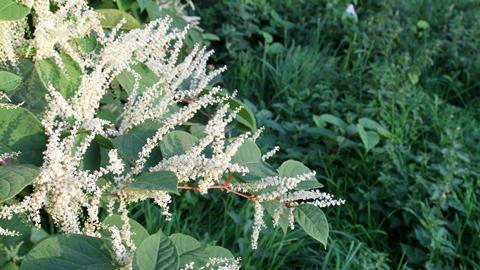Few invasive plants capture attention and headlines like Japanese knotweed. While ecologically harmful, it was the real and perceived impacts on homes and property sales that captured the public’s imagination and fears. Recent research and changes to guidance issued by the Royal Institution of Chartered Surveyors (RICS) and the Law Society’s Property Information Form (TA6) have recalibrated our perceptions around this troublesome weed.
For many years the presence of Japanese knotweed within seven metres of a property would cause mortgage lenders to reconsider lending decisions. The ‘seven-metre rule’ was based on estimated below ground lateral rhizome (root) spread described in the Environment Agency 2006 Knotweed Code of Practice and later in the RICS 2012 Japanese knotweed and residential property information paper that advised surveyors on infestations. The science behind the seven-metre rule was less clear and was compounded by reports of structural damage caused by the plant and limited evidence on how it could be controlled.
In 2018, large scale field-based research by Swansea University identified management strategies to control Japanese knotweed, recognising that eradication was hard to achieve and, while above ground growth could be removed, the plant survived as dormant below ground rhizome. Fennell and co-workers’ desk-study described typical knotweed growth processes in the context of residential property damage, indicating that three-metre rhizome spread, not seven, was more appropriate. The summer of 2018 also saw the Court of Appeal judgment in Network Rail Infrastructure Ltd v (1) Williams (2) Waistell [2018] EWCA Civ 1514 citing loss of amenity caused by the encroachment of Japanese knotweed rhizomes.
Following a House of Commons Science & Technology Committee (HCSTC) inquiry focussing on Japanese knotweed and the built environment in 2019, Defra commissioned a study on international approaches to Japanese knotweed in property sales. In response, the Law Society published a 2020 update to the Property Information Form (TA6) and explanatory notes on four areas including Japanese knotweed. The revised explanatory notes advise that if a seller is unsure that knotweed exists above or below ground or whether it has previously been managed on the property, please indicate this as ‘Not known’. If ‘No’ is chosen as an answer the seller must be certain that no rhizome is present in the ground of the property, or within three metres of the property boundary even if there are no visible signs of growth above ground.
The revised guidance was given because sellers being unable to identify Japanese knotweed or understand the implications of its presence were frequently checking the ‘No’ box leading to misrepresentation claims and in some cases litigation. The main impact of this change has been to remove the ambiguity on liability if below ground dormant knotweed is present for all house sales using the TA6 form (approximately 1 million residential property transactions are carried out in England and Wales per annum).
Defra’s ‘International Approaches to Japanese knotweed in the Context of Property Sales’ report, to which the authors contributed, went on to inform RICS revised standards and guidance published this year on Japanese knotweed and residential property effective from 23 March 2022.
A key takeaway from the revised RICS guidance is that Japanese knotweed rarely causes structural damage to substantial buildings such as dwellings and is not typically associated with major issues such as subsidence, heave or impact damage. Importantly, the new guidance has dropped the seven-metre property proximity threshold, in favour of the evidence-based three-metre threshold, which was inserted into the revised Law Society explanatory memorandum back in 2020. Further, reporting requirements to lenders will now be more nuanced reflecting the real impact of knotweed to amenity based on the practical challenges of eradication and with a preferred approach to proportionate management.
While guidance notes ‘linguistic alarmism’ in the media as a significant influence on public opinion, Japanese knotweed does differ from other vigorous plants in requiring more time to control (typically 3-5 years) and being costly to remediate/eradicate in short periods of time. Knotweed is described as causing a nuisance and impacting land amenity value negatively and quite how the public perception issues around knotweed will be addressed practically remain to be seen.
The hope is that the revised RICS guidance will increase approved mortgage offers on affected properties that have a clear management plan in place. No doubt there will be a period of bedding in for the new guidance and the market will take time to adapt; however, disentangling fact from fiction permits us to address the misplaced fear of Japanese knotweed and should enable us to revaluate the plant in the context of industry changes and responses to the presence of knotweed on property.
Michael Draper is chair of the Law Society’s conveyancing and land law committee
Dan Eastwood is professor in ecological biosciences at Swansea University
Dr Dan Jones is managing director at Advanced Invasives and honorary researcher at Swansea University
































1 Reader's comment